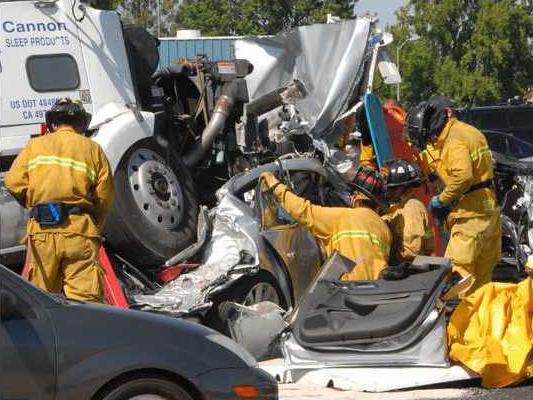Before the next 36 hours pass the odds are there will be a significant crash on the 120 Bypass with it most likely to occur in the last mile of the eastbound lanes — a stretch Manteca Councilman Mike Morowit calls “the death alley of the city” — prior to the Highway 99 interchange.
And when you toss in the segment on Highway 99 from Austin Road to the 120 Bypass, Manteca Mayor Steve DeBrum notes that in the past eight years there have been 1,700 accidents, 900 injuries and 17 deaths. Worse yet, six of the deaths have happened in the last two years prompting DeBrum to grimly note that the carnage is getting worse.
It is against that background a frustrated City Council made it clear Tuesday that the effort to get Caltrans’s $82 million solution in place that would address operational movements such as the deadly lane merges, improve traffic flow, and increase vehicle capacity must become a reality as soon as possible.
But in order for it to be built the regional effort underway needs to convince state and/or federal officials to commit funds beyond $23 million that is expected to come from local sources.
The 120 Bypass was the main regional project the San Joaquin One Voice group of 40 plus elected leaders and key government staff advocated to federal agencies and representatives during last month’s lobbying trip to Washington, D.C.
Councilwoman Debby Moorhead noted it has been coming up year after year in meetings with federal officials but she said “you feel as if we’re talking to a wall.” She did note that when statistics are shared about how deadly the one mile of freeway is, it does grab their attention.
“We need help,” Moorhead said.
But the best that was offered during the trip to DC was a suggestion that perhaps a toll lane could be built.
That just further frustrated Moorhead who said someone has to represent the people who have died on the Bypass in a bid to stop even more deaths that are significantly higher than an average mile of freeway in California.
She noted at one point in a meeting with federal Department of Transportation bureaucrats that Morowit said, “I’m getting tired of people leaving our city in body bags.”
Morowit at Tuesday’s council meeting said that the carnage is so bad that the fire department in planning the city’s fifth fire station at Atherton Drive and Woodward Avenue within a half mile of the 99/120 Bypass interchange expects a large segment of its calls will be to 120 Bypass accidents.
Moorhead noted the 120 Bypass was never designed to become the critical connector it is today where 25 percent of the agricultural production of the Northern San Joaquin Valley moves through the interchange to market or for the movement of commuters and goods to the Bay Area.
She said it was intended to get “weekend warriors” headed to the Sierra off Manteca streets where traffic in the 1970s would back up for miles on Fridays and Sundays as vehicles snaked through going to and from the Bay Area. Today the daily traffic count is at 85,000 vehicles a day and climbing.
The congestion as well as delays from accidents has gotten so bad in recent years that commuters heading south into Stanislaus County will get off of the Bypass when traffic backs up and use Woodward Avenue to reach Moffat and then Highway 99 as a bypass of the 120 Bypass or even head farther south down country roads into Ripon and get on the freeway there.
Prior to the meeting Moorhead said the city needs to step up efforts to secure funding which would require the active and continuous backing of Manteca residents and those in nearby community to repeat the effort that secured the regional bypass funding. Back in the 1970s, a bypass of Manteca wasn’t in the plans until 30 years in the future. The same was true of upgrades to the 120 Bypass/Highway 99 interchange that wasn’t even on Caltrans’ radar until five years ago when a push started to address operational and safety issues that have significantly worsened as the 209 takes on a bigger role in providing affordable housing for the job rich Bay Area.
Statistics provided by the CHP last year indicated there is an accident every 1.5 days that is serious enough to require a CHP response. The bulk of the accidents — and where almost every death occurs — is in the eastbound lanes in the 1.5-mile stretch starting midway between the Union Road and Main Street interchanges and the Highway 99 transition ramps.
Back in 2010 an accident requiring CHP response happened every 2.8 days on the 120 Bypass.
To emphasize the regional importance of the 120 Bypass and the need for safety improvements a 2014 University of Pacific Eberhardt School of Business Forecasting Center report notes the largest inter-regional commute for Merced County (6,435 residents) and for Stanislaus County (17,550 residents) was to the greater Bay Area. The vast majority of those commuters pass through the 120 Bypass/Highway 99 interchange. The lion’s share of fatalities and injuries are victims with hometowns from the two counties to the south.
Most of the accidents are the result of traffic slowdowns nearing Highway 99. What happens typically are drivers will cut over into the right lane at the last possible second forcing cars and trucks already going slower in the right hand lane often to hit their brakes. That triggers a chain reaction of brake lights and sets the stage for a Slinky-style traffic pattern.
DeBrum noted the goal the San Joaquin Council of Governments and Caltrans has put in place to tentatively start work in the summer of 2021 is fairly aggressive considering what has to be done and the need to secure funding.
DEATH ALLEY OF THE VALLEY
Deadly 120 Bypass mile: We need help





